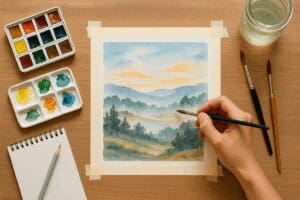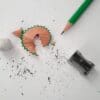Oil painting is a versatile medium that has captivated artists for centuries. From the delicate, smooth strokes of the Renaissance to the bold, expressive brushwork of modern art, oil paint offers a range of possibilities for creativity. One of the most exciting techniques in oil painting is impasto, which involves applying thick layers of paint to create texture and dimension. In this guide, we’ll delve into the world of impasto, exploring its history, techniques, and how to incorporate it into various styles of oil painting.
What is Impasto?
Impasto is an Italian term that means “paste” or “dough,” which accurately describes the thick, textured application of paint on the canvas. Unlike traditional smooth layers, impasto creates a three-dimensional effect, allowing light to reflect off the surface in unique ways. This technique adds a tactile quality to the artwork, making it more dynamic and engaging.
Historical Background of Impasto
The use of impasto can be traced back to the 16th century, but it gained significant popularity during the Baroque period. Artists like Rembrandt used impasto to highlight light and shadow, adding a sense of realism and depth to their works. The technique was further embraced by the Impressionists, with Vincent van Gogh being one of the most notable proponents. His swirling, vibrant impasto strokes are instantly recognizable and continue to inspire artists today.
Materials and Tools for Impasto
Before diving into impasto techniques, it’s essential to gather the right materials. Here’s what you’ll need:
- Oil Paints: High-quality, thick oil paints are ideal for impasto. Brands like Winsor & Newton, Gamblin, and Sennelier are known for their rich, buttery consistency.
- Palette Knives: These come in various shapes and sizes and are perfect for applying and sculpting thick layers of paint. Palette knives offer more control over the texture compared to brushes.
- Brushes: While palette knives are essential, sturdy bristle brushes can also be used for impasto. Look for hog bristle or synthetic bristle brushes that can handle the thickness of the paint.
- Mediums: Impasto mediums can be mixed with oil paints to enhance their thickness and drying time. Consider using products like Liquin Impasto by Winsor & Newton or Gamblin’s Cold Wax Medium.
- Canvas: Choose a canvas with a sturdy surface that can support the weight of thick paint layers. Pre-primed canvases or wood panels are excellent options.
Basic Impasto Techniques
- Direct Application: Load your brush or palette knife with a generous amount of paint and apply it directly to the canvas. Experiment with different angles and pressures to create varied textures.
- Layering: Build up layers of paint to enhance the three-dimensional effect. Allow the first layer to dry slightly before adding subsequent layers to avoid blending the colors too much.
- Sculpting: Use the edge of your palette knife to carve and sculpt the paint, creating intricate details and patterns. This technique is particularly effective for depicting natural elements like foliage and waves.
- Dry Brush: After applying a thick layer of paint, use a dry brush to drag and manipulate the surface, creating interesting textures and highlighting brushstrokes.
- Blending and Smudging: While impasto is known for its bold textures, you can also blend and smudge areas to soften transitions and create a balance between smooth and textured surfaces.
Incorporating Impasto into Various Styles
Impasto is incredibly versatile and can be adapted to various painting styles. Let’s explore how to incorporate impasto into different artistic approaches.
Impressionism
Impressionist artists like Claude Monet and Pierre-Auguste Renoir used impasto to capture the fleeting effects of light and color. To incorporate impasto into an Impressionist style:
- Focus on capturing the essence of the scene rather than precise details.
- Use short, quick strokes with a palette knife to create vibrant textures.
- Experiment with complementary colors to enhance the vibrancy and depth of your painting.
Expressionism
Expressionism is all about conveying emotion through bold, exaggerated forms and colors. Artists like Edvard Munch and Wassily Kandinsky used impasto to intensify the emotional impact of their works. To achieve an Expressionist look with impasto:
- Use thick, aggressive strokes to convey energy and emotion.
- Allow the paint to build up in areas to create a sense of movement and intensity.
- Don’t be afraid to let your emotions guide your brushwork, creating a raw, visceral effect.
Abstract Art
Abstract artists like Jackson Pollock and Willem de Kooning often used impasto to add a physical presence to their work. To incorporate impasto into abstract painting:
- Focus on the texture and form rather than representational imagery.
- Experiment with layering and scraping paint to reveal underlying colors and textures.
- Use unconventional tools like spatulas, sponges, or even your hands to apply and manipulate the paint.
Realism
While impasto is often associated with more expressive styles, it can also be used in realistic painting to add depth and dimension. Artists like Lucian Freud used impasto to create lifelike textures in skin and fabric. To incorporate impasto into a realistic style:
- Use impasto selectively to highlight specific areas, such as the texture of skin or the folds of fabric.
- Pay attention to the direction of light and shadow, using impasto to enhance the three-dimensional effect.
- Combine impasto with more refined, detailed brushwork to create a balance between realism and texture.
Advanced Impasto Techniques
Once you’re comfortable with basic impasto techniques, you can explore more advanced methods to elevate your artwork.
- Glazing Over Impasto: After your impasto layers have dried, apply thin glazes of transparent paint to create depth and luminosity. This technique adds a rich, complex quality to your work.
- Sgraffito: This involves scratching into the wet paint with a sharp tool to reveal the layers beneath. Sgraffito adds intricate details and texture to your impasto painting.
- Mixed Media: Combine impasto with other media like acrylics, pastels, or collage elements. This approach adds a unique, multi-dimensional aspect to your work.
- Impasto with Metallics: Incorporate metallic paints or leafing into your impasto layers. The reflective quality of metallics enhances the texture and adds a luxurious touch to your artwork.
Tips for Working with Impasto
- Plan Your Composition: While impasto allows for spontaneity, it’s helpful to have a rough plan for your composition. Consider where you want to place your thickest textures and how they will interact with other elements.
- Mind Your Drying Time: Thick layers of oil paint can take a long time to dry. Be patient and allow each layer to dry adequately before adding more paint.
- Clean Your Tools: Impasto can be tough on brushes and palette knives. Clean your tools thoroughly after each session to maintain their quality.
- Experiment and Have Fun: Impasto is a dynamic, expressive technique. Don’t be afraid to experiment and embrace the unexpected results.
Learning from the Masters
Studying the works of artists who mastered impasto can provide valuable insights and inspiration. Here are a few artists to explore:
- Vincent van Gogh: His bold, swirling impasto strokes bring his subjects to life with incredible energy and emotion.
- Claude Monet: Monet’s use of impasto in his water lily series creates a vibrant, almost tactile quality.
- Rembrandt: His masterful use of light and shadow, enhanced by impasto, adds a sense of realism and drama to his portraits.
Online Resources and Tutorials
To further enhance your impasto skills, consider exploring these online resources:
- Winsor & Newton – Impasto Techniques
- Gamblin – Cold Wax Medium
- Skillshare – Oil Painting for Beginners
- YouTube – Impasto Oil Painting Techniques
Conclusion
Impasto is a powerful technique that adds texture, dimension, and emotion to your oil paintings. Whether you’re an experienced artist or a beginner, incorporating impasto can elevate your work to new heights. By experimenting with different tools, techniques, and styles, you can discover the endless possibilities that impasto offers. So grab your palette knife, load up your brush, and start exploring the rich, textured world of impasto oil painting.
For more inspiration and tips on oil painting, follow us on social media and join our community of artists.
*For collaborations, art features, or inquiries, please contact us at [email protected]. Don’t forget to follow us on Instagram, Facebook, Twitter.
Disclaimer: The views and opinions expressed in this article do not necessarily reflect the official policy or position of Irish Artmart.
Happy painting!




